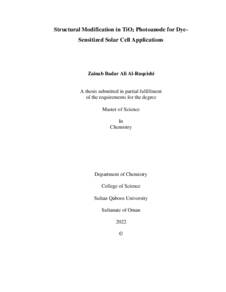وثيقة
Structural modification in TiO2 photoanode for dye sensitized solar cell applications.
الناشر
Sultan Qaboos University.
ميلادي
2022
اللغة
الأنجليزية
الموضوع
الملخص الإنجليزي
In the present work, four gold nanorods (Au NRs) with different aspect ratios were
successfully synthesized for potential use in the photoanode of DSSCs. Different aspect
ratios of Au NRs were developed to enhance the photoanode absorption in the visible to
near-infrared (NIR) spectral region while reducing electron-hole recombination in the
TiO2 semiconductor layer. A seed mediated method was employed to synthesize Au NRs
in which different concentrations of AgNO3 were used to change the length and diameter
of Au NRs. Several characterization techniques were utilized to investigate the interaction
of Au NRs with TiO2 nanoparticles and a photosensitizer dye. Scanning electron
microscopy confirmed the successful decoration of Au NRs on the TiO2 surface. X-ray
photoelectron spectroscopy (XPS) measurements suggested a transfer of electronic charge
from Au NRs to TiO2 NPs which was indicated by a negative binding energy shift in Ti
2p and O 1s peaks. In addition, O 1s XPS spectra revealed a high-energy small peak, in
addition to the major O2-
peak, which is attributed to the existence of weakly adsorbed
species. Furthermore, the intensity of the small peak indicates that utilizing Au NRs with
a small aspect ratio boosts the adhesion between Au and TiO2. XRD patterns of TiO2
nanocomposites demonstrate the presence of mixed anatase and rutile phases. Also, the
XRD results point to the robustness of the TiO2 support during the synthesis of
nanocomposites since the crystal structures of anatase and rutile were preserved and the
positions of their XRD diffraction peaks did not shift. In the remaining work, we
proceeded with two of the prepared Au NRs, namely Au NR50 (smallest aspect ratio) and
Au NR105 (one of the large aspect ratios prepared).
The Photoluminescence (PL) analyses of TiO2 revealed the existence of 5 defect states in
all samples with absorbance in the visible region except one defect state in the ultraviolet
region. Two mechanisms were adapted to explain the enhancement in near band emission
(NBE) peak and the reduction of defect bands' intensity in the PL spectra after decorating
TiO2 with Au NRs. The intensity of NBE for TiO2 NPs decorated with a small aspect ratio
of Au NRs (Au NR50) is higher while the defect states intensity is lower, compared to the
nanocomposite with the large aspect ratio (Au NR105). This observation implies a more
efficient interaction between TiO2 NPs and Au NRs with an aspect ratio close in size to
the TiO2 NPs. The fluorescence decay of the Au NRs@TiO2 nanocomposites indicates a
degree of heterogeneity around the crystalline form of TiO2. The average lifetime was
estimated to be 0.69 ns for TiO2 and gets longer in the presence of gold nanorods. The
elongation in lifetime indicates better electron-hole separation that is attributed to the
formation of a Schottky barrier at the interface between TiO2 and Au NRs which acts as
an electron sink. The longer separation time in Au NR50@TiO2 nanocomposite
(compared to Au NR105@TiO2) suggests a more rigid Schottky barrier is formed at the
metal/TiO2 interface, resulting in more electron trapping in the excited state and less
electron-hole recombination.
To understand the overall spectroscopy of the modified TiO2 photoanode, the effect of the
presence of gold nanorods on the spectroscopic signals of a new photosensitizer organic
dye (DC-COOH) was investigated. The change in the fluorescence intensity and the
average fluorescence lifetime of the dye indicates that both static and dynamic quenching
mechanisms were operative where the former was found to be more dominant. The FRET
parameters indicate that Au NRs are capable of quenching the dye's fluorescence from a
long distance, with high energy transfer efficiencies. This is a consequence of the very
large extinction coefficients (5.20 × 109 M-1
cm-1
) of the nanorods. Femtosecond transient
absorption spectra of Au NRs gave an intuitive picture of the surface plasmon oscillations
due to the excitation of the electrons in the gold nanorods. The measured dynamics for the
transverse and longitudinal bleach bands in each of the two systems (Au NR50 and Au
NR105) are almost the same. In order to gain more understanding of the interaction
between the organic dye and the Au NRs, we measured here the same ultrafast dynamics
when the dye was mixed with the two Au NRs. The interaction of the dye with Au NR of
a large aspect ratio (Au NR105) has no significant effect on the absorption and bleach
bands, except for a small change in intensity. On the other hand, the dye causes a slight
red shift in the bleach bands of Au NR50, indicating a small change in the aspect ratio and
also the diameter. Although the dye molecules are expected to attach to both nanorods in
a similar manner, it seems from these results that the presence of the dye molecules causes
more effect on the surface dimensions of small aspect ratio Au NRs. Moreover, the
extracted time constants in the presence of the dye are similar to those of pristine Au NRs.
Thus, we can conclude that the gold nanorods are highly resistive to the surrounding
environment.
The results presented in this thesis show that the presence of Au enhances electron
trapping on the TiO2 surface which is expected to lead to better solar-to-electrical
conversion efficiency. The results of this work should also be useful as a benchmark for
more modifications in the TiO2 photoanode which may include testing the effect of
changing separately the diameter and the length of the Au NRs, and testing
nanocomposites of different mixtures of Au and Ag nanorods. Other photosensitizer dyes
should also be considered.
المجموعة
URL المصدر
قالب العنصر
الرسائل والأطروحات الجامعية

